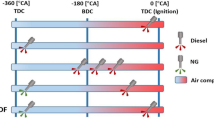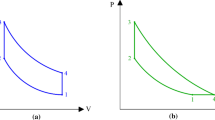Abstract
Recently, the environmental crisis and the negative influence of gasoline and diesel fuels on it, together with these fuels high cost persuaded manufacturing companies to use natural gas as substitute fuel. Considering the same volumetric efficiency and fuel penetration, natural gas needs more space because of its much lower density in comparison to liquid fuels. In this regard, the Miller cycle as the fifth-thermodynamic cycle in internal combustion engines is discussed. Increasing the expansion ratio along with the compression by changing in the intake valve closure is the main characteristic of this cycle. In this study, AVL FIRE software is used to simulate D87 gas engine. Since the close cycle cannot examine valve lifting effectively as well as turbo charging, one-dimensional simulation by GT Power software is used. After their parallelism with each other, four camshaft timing was used as well as Otto cycle. Results show that there is a reduction in the maximum pressure and temperature with slight increment in power. Also due to decrease in peak temperature, NOx diminishes obviously.
















Similar content being viewed by others
Abbreviations
- CFD:
-
Computational fluid dynamic
- BSFC:
-
Brake specific fuel consumption
- EIVC:
-
Early intake valve closure
- SI:
-
Spark ignition
- IVC:
-
Intake valve closing
- EVC:
-
Exhaust valve closure
- BDC:
-
Bottom dead center
- ABDC:
-
After bottom dead center
- K:
-
Kelvin
- P:
-
Pressure
- BMEP:
-
Brake mean effective pressure
- IVC:
-
Intake valve closure
- LIVC:
-
Late intake valve closure
- IVO:
-
Exhaust valve closure
- EVO:
-
Exhaust valve opening
- TDC:
-
Top dead center
- BTDC:
-
Before top dead center
- CR:
-
Compression ratio
- VE:
-
Volumetric efficiency
- T:
-
Temperature
References
Kalam MA, Masjuki HH, Maleque MA, Amalina MA, Abdesselam H, Mahlia TMI, Aslam MU, Varman M. Power improvement of a modified natural gas engine. Department of Mechanical Engineering, University of Malaya
Ebrahimi R, Mercier M (2011) Experimental study of performance of spark ignition engine with gasoline and natural gas. IJE Trans B Appl 24(1)
Miller RH (1947) Supercharging and internal cooling cycle for high output. Trans ASME 69:453–457
Martins J, Uzuneanu K, Ribeiro B, Jasasky O (2004) Thermodynamic analysis of an over-expaned engine. SAE. 01-0617
Al-Sarkhi A, Jaber JO, Probert SD (2006) Efficiency of a Miller engine. Appl Energy 83:343–351
Ebrahimi R (2011) Thermodynamic modeling of performance of a Miller cycle with engine speed and variable specific heat ratio of working fluid. Comput Math Appl 62:2169–2176
Yorihiro F, Hiromi S, Yoshitaka K, Hiroyuki E, Kengo T (2001) Development of high efficiency Miller cycle gas engine.Mitsubishi Heavy Industry, Ltd. Tech Rev 38(3):146–150
Wu C, Puzinauskas PV, Tsai JS (2003) Performance analysis and optimization of a supercharged Miller cycle Otto engine. Appl Therm Eng 23:511–521
Anderson MK, Assanis DN, Filipi ZS (1998) First and second law analyses of a natural-aspirated, Miller cycle, SI engine with late intake valve closure. SAE Int Paper 980889:1–16
Mikalsen R, Wang YD, Roskilly AP (2009) A comparison of Miller and Otto cycle natural gas engines for small scale CHP applications. Appl Energy 86:922–927
Yamada T, Shimomura S Development of new DAIHATSU 2 MW class gas engine. CIMAC, Paper No. 248
Matsushita Y, Tsuji N, Tanaka K, Noguchi T Development of high efficient miller cycle gaz engine. Osaka gas and Mitsubishi Heavy Industries
Gyeung HC et al. (2007) An experimental and numerical study of a miller cycle for gas engine converted from a diesel engine. ASME/IEEE joint rail conference and internal combustion engine spring technical conference, pp 1–6
Wang Y, Lin L, Roskilly AP, Zeng S, Huang J, He Y, Huang X, Huang H, Wei H, Li S, Yang J (2007) An analytic study of applying Miller cycle to reduce NOx emission from petrol engine. Appl Therm Eng 27:1779–1789
Poompiaptpong C (2007) Effects of intake valve timing and injection timing in a natural gas dedicated diesel engine. A Thesis submitted in partial fulfillment of the requirements for the Master of Science in automotive engineering, Department of Mechanical and Automotive Engineering, Keimyung University, Republic of South Korea
Chih Wu, Puzinauskas Paul V, Tsai JS (2003) Performance analysis and optimization of a supercharged Miller cycle Otto engine. Appl Therm Eng 23:511–521
Lee JH (2006) A Study of the thermal efficiency on the industrial engine with Miller cycle. Master Thesis, Department of Automotive Engineering, Graduate School, Keimyung University
AVL FIRE Software, Combustion Module, V2013
Benson RS, White House ND (1979) Internal combustion engine Pergamon Press Ltd, Oxford
Author information
Authors and Affiliations
Corresponding author
Additional information
Technical Editor: Luis Fernando Figueira da Silva.
Rights and permissions
About this article
Cite this article
Tavakoli, S., Domiri Ganji, D., Gorji, M. et al. Different camshaft profile analyses for natural gas engine performance and emission. J Braz. Soc. Mech. Sci. Eng. 38, 355–364 (2016). https://doi.org/10.1007/s40430-015-0317-5
Received:
Accepted:
Published:
Issue Date:
DOI: https://doi.org/10.1007/s40430-015-0317-5




